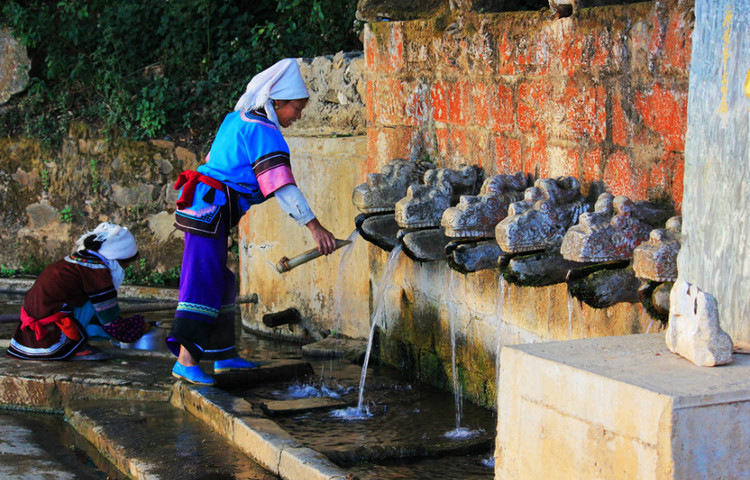 alt="Puer Surrounding Counties and Towns: Weekly & Special Local Markets Travel Guide"
/>
alt="Puer Surrounding Counties and Towns: Weekly & Special Local Markets Travel Guide"
/>
Tasa 12 Springs in Honghe County, Honghe
Introduction
Tasa (他撒村) is located in the central-eastern part of Honghe County (红河县), Yunnan Province (云南省), and is home to the largest Hani (哈尼族) village in the country. It is renowned for its vibrant song and dance culture. Among its attractions, the Twelve Springs (十二龙泉) of Tasa Village are particularly famous, known for their sweet, cool mountain spring water that emerges from the rock crevices.
The Twelve Springs
The Twelve Springs十二龙泉 consist of twelve distinct streams of spring water, divided into two groups of six outlets each. The left group serves as a drinking water source, featuring outlets decorated with animal heads, while the right group, adorned with stone troughs, is designated for washing vegetables and clothes.
The Hani people are particularly protective of this precious water source. They prohibit climbing near the spring and littering. Every year, in the sixth month of the lunar calendar, they perform a ritual, offering chickens and ducks at the site to express gratitude for the abundance of water that nourishes their rice terraces.
The Twelve Springs are situated on Tasa Qiluo Road (齐洛公路) in Honghe County, about 50 meters north of the Twelve Springs viewing platform.
Unique Natural Landscape
The Twelve Springs are a unique natural landscape, celebrated for their clear, sweet water and the distinctive quantity of twelve streams. The springs flow year-round, refreshing both locals and visitors alike. Surrounding the springs are lush mountains, filled with the sounds of birds and fragrant flowers. In spring, the “Tuo Tan Mai” (妥垤玛依) and red mountain tea flowers bloom, creating a picturesque scene. This area is not only an ideal choice for spring excursions and summer retreats but also a perfect spot to unwind and enjoy nature.
Overall, the Twelve Springs combine natural beauty, cultural history, and folk traditions, making it a must-visit destination.
Cultural Significance
The Twelve Springs are intertwined with local folklore. According to legend, in ancient times, Tasa Village had a unique marriage custom where men would marry but women would not. A family with a son and daughter found themselves in a dilemma when the son did not wish to leave home. The daughter agreed to marry on his behalf, but only if half of the Twelve Springs were given to her as a dowry. The village elders agreed, altering the marriage custom forever. In gratitude, the Hani’s local shaman performed a sacred ceremony, bestowing twelve blessings upon the spring water, ensuring that anyone who drinks from it receives the protection of the Hani mountain spirits. The blessings include health, happiness, wealth, and harmony, among others.
Hani Culture and Water Worship
Hani sculptures are closely linked to their wells and the reverence for water. The Hani believe that clean water sources bring good fortune. As such, the sculptures near the Twelve Springs are designed to ward off evil spirits, ensuring the purity of the water. The sculpture group comprises six outlets with animal head carvings and six stone troughs, flowing into a nearby reservoir for washing vegetables and clothes.
The well serves not only as a water source but also as a sophisticated irrigation system, showcasing the ingenuity of the Hani people. Their sustainable methods ensure that water is efficiently distributed among the countless rice terraces in the area.
Nearby Attractions
7.4 kilometers from the Twelve Springs is the scenic area of the Jiangshan Reservoir (甲寅后山水库), a natural alpine lake at an elevation of 2,200 meters. Surrounded by over 4,000 acres of forest, this area epitomizes the harmony between mountains and water. In spring, the “Tuo Tan Mai” and red mountain tea flowers bloom, creating an idyllic setting for relaxation and exploration.
Location
The Twelve Springs are located at Longjia Village (龙甲村), Z002 County Road, Honghe County, Honghe Hani and Yi Autonomous Prefecture (红河哈尼族彝族自治州).
How to Get There
To reach the Twelve Springs, take a bus or drive from Honghe County to Tasa Village. The journey from the county seat to Tasa takes about 30 minutes. Signage along the route will guide you to the springs.
Travel Tips
- Best Time to Visit: Spring (March to May) is ideal for experiencing blooming flowers and enjoying mild weather.
- Local Customs: Respect local traditions, especially around the springs, and avoid littering.
- Photography: Bring a camera to capture the stunning landscapes and cultural artifacts.
- Hiking Gear: If you plan to explore the surrounding areas, wear comfortable shoes suitable for hiking.
- Stay Hydrated: Drink plenty of water, especially when engaging in outdoor activities.


 7 Days GolfingTour
7 Days GolfingTour
 8 Days Group Tour
8 Days Group Tour
 8 Days Yunnan Tour
8 Days Yunnan Tour
 7 Days Shangri La Hiking
7 Days Shangri La Hiking
 11 Days Yunnan Tour
11 Days Yunnan Tour
 6 Days Yuanyang Terraces
6 Days Yuanyang Terraces
 11 Days Yunnan Tour
11 Days Yunnan Tour
 8 Days South Yunnan
8 Days South Yunnan
 7 Days Tea Tour
7 Days Tea Tour
 8 Days Muslim Tour
8 Days Muslim Tour
 12 Days Self-Driving
12 Days Self-Driving
 4 Days Haba Climbing
4 Days Haba Climbing
 Tiger Leaping Gorge
Tiger Leaping Gorge
 Stone Forest
Stone Forest
 Yunnan-Tibet
Yunnan-Tibet
 Hani Rice Terraces
Hani Rice Terraces
 Kunming
Kunming
 Lijiang
Lijiang
 Shangri-la
Shangri-la
 Dali
Dali
 XishuangBanna
XishuangBanna
 Honghe
Honghe
 Kunming
Kunming
 Lijiang
Lijiang
 Shangri-la
Shangri-la
 Yuanyang Rice Terraces
Yuanyang Rice Terraces
 Nujiang
Nujiang
 XishuangBanna
XishuangBanna
 Spring City Golf
Spring City Golf
 Snow Mountain Golf
Snow Mountain Golf
 Stone Mountain Golf
Stone Mountain Golf














 What Our Customers Say?
What Our Customers Say?
